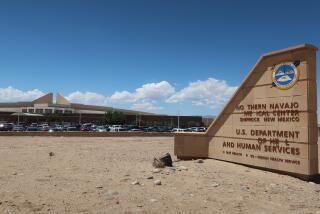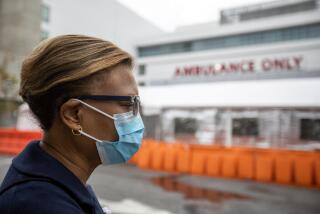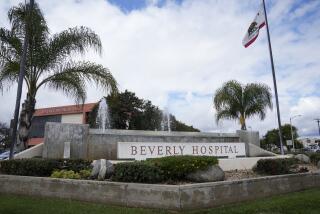Inner-City Hospitals Face Finance Crisis in AIDS Care
- Share via
The AIDS epidemic is threatening to financially overwhelm inner-city hospitals, limiting their ability to treat other patients and raising the specter of health-care rationing, according to a study to be published today in the Journal of the American Medical Assn.
The study of 276 hospitals in 39 states was conducted by the National Public Health and Hospital Institute and represents the most comprehensive survey to date of the financial impact on hospitals of treating AIDS patients. No individual hospitals were cited in the study.
The report paints AIDS as a disease of the poor and the medically disenfranchised, underscoring the contention of Dr. David Rogers, vice chairman of the National Commission on AIDS, that “AIDS is a one-way ticket to poverty.”
In 1987, the year on which the survey was based, 44% of AIDS patients admitted to hospitals were covered by Medicaid, 29% were covered by private medical insurance and 23% were indigent or uninsured.
For hospitals, the impoverished patient population means low reimbursement rates from Medicaid or no payment at all from indigents who lack medical insurance. As a result, public hospitals, which treat poorer patients, lost $218 per AIDS patient per day on average, more than double the $92 a day loss sustained by private hospitals.
The average daily per patient loss at public hospitals in the South was much higher--$386--because of strict eligibility requirements for Medicaid there. In the West, public hospitals lost an average of $77 a day per AIDS patient.
The situation for outpatient care for AIDS patients was even worse: Nationwide, public hospitals collect just 14 cents for every dollar’s worth of such care that they provide, according to the survey.
As the financial drain of AIDS grows, hard-hit hospitals may be forced to cut back on emergency-room services, trauma care, burn units, neonatal care and other critically needed services, warned the study’s author, Dennis Andrulis.
“Like it or not, AIDS is a communitywide problem and demands a communitywide solution,” Andrulis said in an interview.
Rationing is already taking place in many hospitals, Andrulis said, “but it is being done in subtle ways.” He pointed to long waits for service in urban public hospitals and overwhelmed emergency rooms.
“God knows what the future will bring,” he added.
To head off the coming crisis, Andrulis proposed more uniform Medicaid eligibility standards nationally, higher Medicaid reimbursement rates and “more effective alternatives to inpatient treatment” for people with AIDS.
“There are many new outpatient treatments coming onto the scene,” he noted. “Who is going to pay for them, especially with reimbursement schedules skewed toward inpatient care?”
“The report points up the need for Medi-Cal to enrich its reimbursement rates for AIDS,” said Edward Foley, the administrator of Los Angeles County Harbor-UCLA Medical Center.
Medi-Cal is California’s version of Medicaid, the joint federal and state medical assistance program for the poor.
Currently, Foley noted, public facilities such as Harbor and County-USC Medical Center take a disproportionate share of Los Angeles AIDS patients. “If Medi-Cal were to increase the reimbursement rate, hospitals like Kaiser, UCLA and Cedars-Sinai would be willing to take more of these patients,” Foley said.
The report found that AIDS patients are disproportionately concentrated in a relatively small number of hospitals. For example, 5% of the hospitals in the survey treated more than 50% of the AIDS patients.
With AIDS cases unevenly distributed throughout the country, the survey said that “it may become more difficult to draw broader political and community support for increased resources from areas and providers not influenced by the epidemic.”
More to Read
Sign up for Essential California
The most important California stories and recommendations in your inbox every morning.
You may occasionally receive promotional content from the Los Angeles Times.













